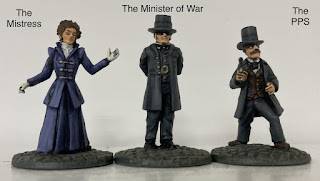Game Report 02: The Slaughterhouse 3 (part 1)

The second game was played between LAFers Captain Blood (German) and OSHIROmodels (British, fielding many of his own troops) with the author as Umpire. Rules were a variation of ‘Rebels & Patriots’. It was a matter of poor timing that just this weekend the Minister of War had been at his Sussex estate. Though planned as an intense working weekend, with much to be done to catch up on developing events in Europe, the Minister had included his mistress in the travelling party. Unfortunately, the Minister’s planned weekend had become overtaken by events. With the Germans Forces having made their surprise landing at Worthing and then quickly advanced towards Horsham, the Minister had been forced to scurry from his estate. The Minister of War, his Personal Private Secretary and his Mistress - The Three - are in now hiding in or near a complex of buildings - The Slaughterhouse - on the road between Worthing and Horsham, at the junction with road to Guildford. It’s not known if anyone...




